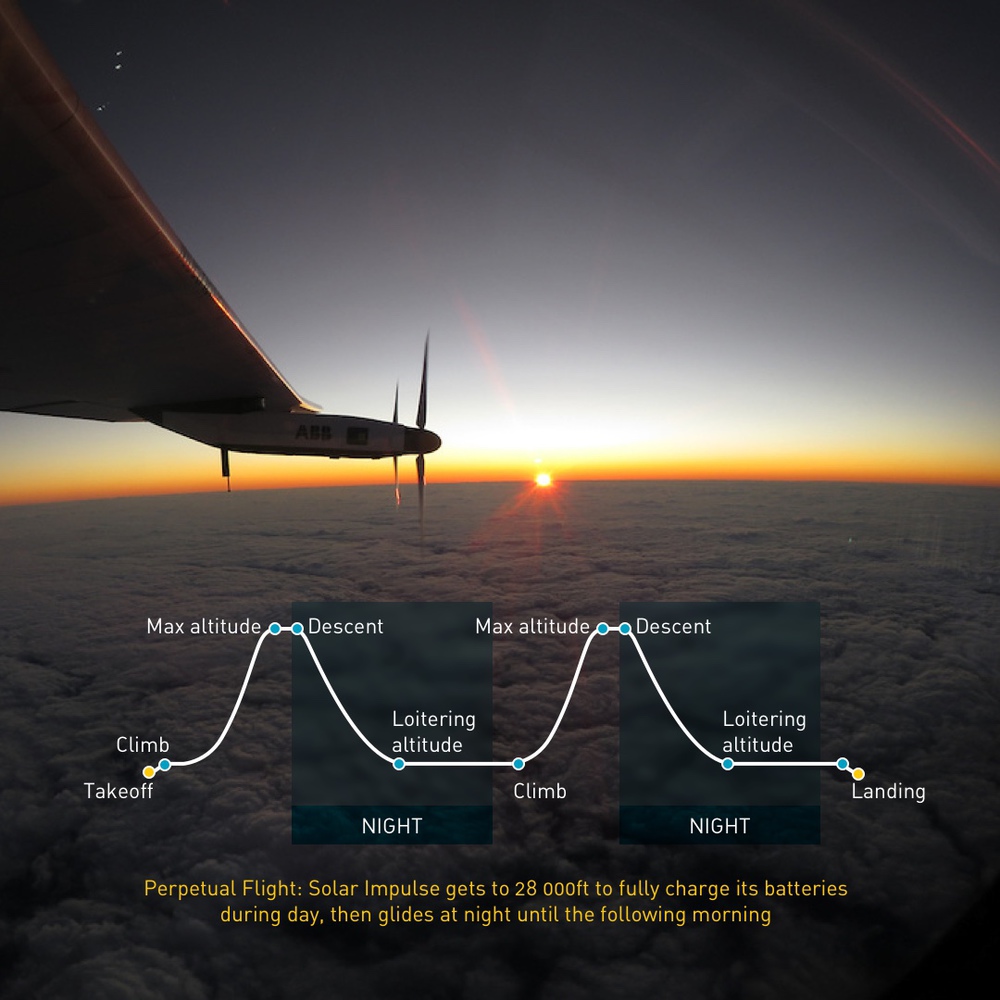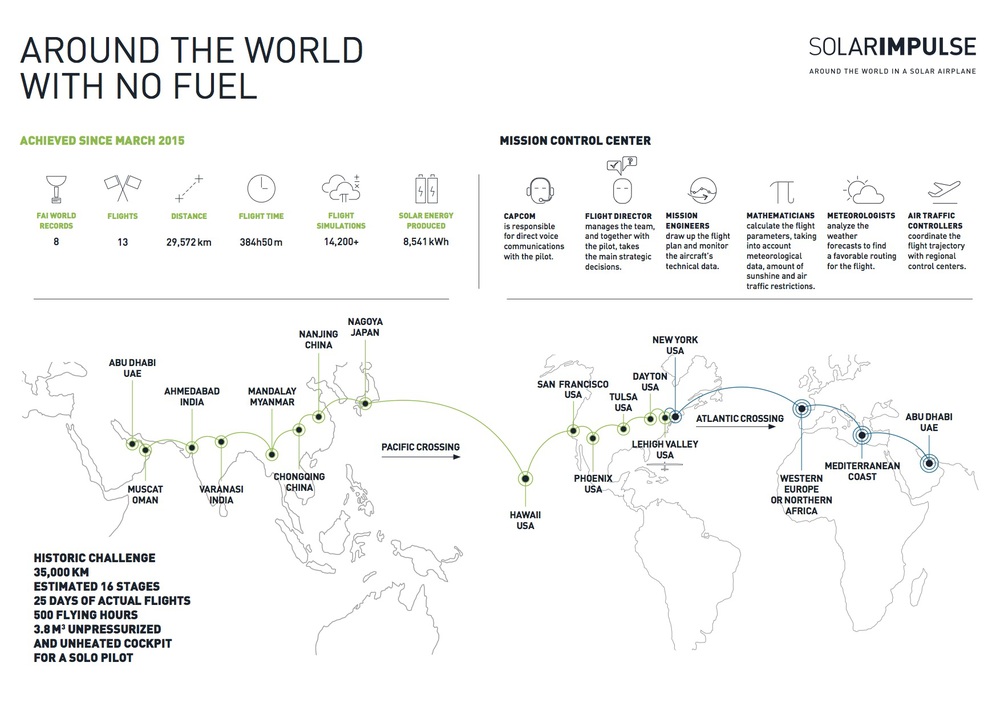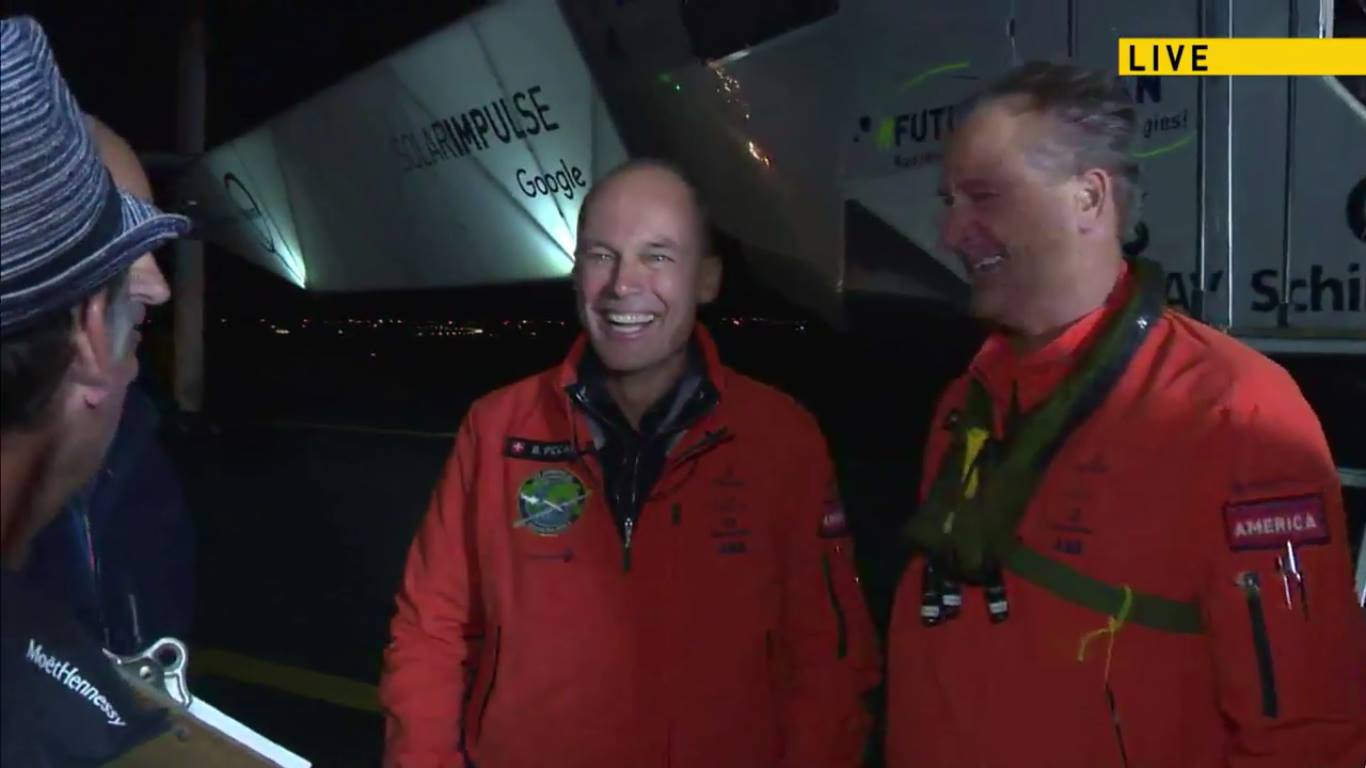On Friday, the Solar Impulse 2 solar-electric airplane landed at JFK Airport in New York, completing the North America leg of its around-the-world journey. The Solar Impulse project, conceived by adventurer Bertrand Piccard and André Borschberg, is seeking to fly around the world while consuming zero fuel. This “zero fuel airplane” is instead powered by solar panels embedded in the wings, with battery packs to store electricity so the plane can fly all night long and the theoretical possibility of perpetual flight. The flight is demonstrating the growing capability of electric vehicles, solar power and energy storage technology.
The North America leg just completed began in April 2016 with a nearly 4 day flight from Hawaii to Moffett Field in Silicon Valley, California. After a few days of meeting with Silicon Valley entrepreneurs, they flew to Phoenix, then to Tulsa Oklahoma, then to Dayton Ohio where they visited with descendants of the Wright Brothers, and then to Lehigh Valley, Pennsylvania. That put them within shouting distance of New York City, and for the team fulfillment of a long-standing team to get pictures of the Solar Impulse flying next to the Statue of Liberty.

June 10th 2016: Andre Borschberg took off from Lehigh Valley to New York, the 14th leg of Round the World Journey and marks the final US leg. Departed from Abu Dhabi on march 9th 2015, the Round-the-World Solar Flight will take 500 flight hours and cover 35000 km. Swiss founders and pilots, Bertrand Piccard and André Borschberg hope to demonstrate how pioneering spirit, innovation and clean technologies can change the world. The duo will take turns flying Solar Impulse 2, changing at each stop and will fly over the Arabian Sea, to India, to Myanmar, to China, across the Pacific Ocean, to the United States, over the Atlantic Ocean to Southern Europe or Northern Africa before finishing the journey by returning to the initial departure point. Landings will be made every few days to switch pilots and organize public events for governments, schools and universities.
Yesterdays flight left the Lehigh Valley International Airport in the evening, flew across Pennsylvania and New Jersey, before entering the New York harbor area at around 2AM local time. After spending over an hour circling the Statue of Liberty, Borschberg flew around the south end of Long Island, into Jamaica Bay, landing at JFK Airport at about 4AM local time.
While their goal is flying around the world with no fuel, this is not to be achieved in one continuous flight. That’s because the Solar Impulse has a very low flight speed (about 30 knots) meaning the trip would take several weeks of continuous flying. Because it is manned by a human pilot, a flight of 4-5 days is possible, but one of several weeks is completely impractical. Instead, the flights tend to take one long day – 17 hours or so – or several days when flying over the ocean.

Which demonstrates the core point of the Solar Impulse’s journey. How does an airplane stay aloft for several days at a stretch? It does this by not being limited in fuel it carries on-board. The solar panels embedded in the wings capture enough electricity during the day so the Solar Impulse 2 can fly all night long. When the sun rises the next day, it can repeat the same pattern, capture enough energy to fly that entire day and through the next night.
Through this journey, the Solar Impulse 2 has covered about 30,000 kilometers, with 384 hours flight time. To do so it has converted nearly 9 megaWatt-hours of sunlight to electricity.

The journey began about a year ago in Abu Dhabi. If all had gone well, the Solar Impulse would have returned to Abu Dabi last Fall. But, during the flight from Nagoya Japan to Hawaii, the battery pack became damaged. The repairs required meant delaying the North America leg of the trip until this year.
The next stage of the journey will see Bertrand Piccard fly across the Atlantic, taking about 4 days. The European destination has not been chosen. The team runs thousands of flight simulations before every trip, looking primarily at changing weather patterns before deciding the next destination in the journey. Tentatively they’re predicting landing in Seville Spain, Toulouse France, perhaps in Morocco, or even in Paris France.
While landing in Paris would let the Solar Impulse connect with the aura of Lindbergh’s flight across the Atlantic, it would complicate the next leg which is to fly to the Eastern Mediterranean. The last leg will go from there (Cyprus? Athens?) to Abu Dhabi. According to discussion on the Solar Impulse Live live show on Friday, their preference is to land in either Seville or Toulouse.

Solar Impulse flying over the Statue of Liberty, courtesy of Solar Impulse Live Stream

Solar Impulse flying over NYC, courtesy of Solar Impulse Live Stream

Solar Impulse arrival at JFK, courtesy of Solar Impulse Live Stream

Bertrand Piccard and Andre Borschberg on the ground at JFK, courtesy of Solar Impulse Live Stream
- Is there enough Grid Capacity for Hydrogen Fuel Cell or Battery Electric cars? - April 23, 2023
- Is Tesla finagling to grab federal NEVI dollars for Supercharger network? - November 15, 2022
- Tesla announces the North American Charging Standard charging connector - November 11, 2022
- Lightning Motorcycles adopts Silicon battery, 5 minute charge time gives 135 miles range - November 9, 2022
- Tesla Autopilot under US Dept of Transportation scrutiny - June 13, 2022
- Spectacular CNG bus fire misrepresented as EV bus fire - April 21, 2022
- Moldova, Ukraine, Georgia, Russia, and the European Energy Crisis - December 21, 2021
- Li-Bridge leading the USA across lithium battery chasm - October 29, 2021
- USA increasing domestic lithium battery research and manufacturing - October 28, 2021
- Electrify America building USA/Canada-wide EV charging network - October 27, 2021












